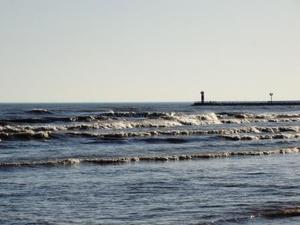Hydroelectric Power Cycle
Hydroelectric Power or hydropower harnesses water to produce electricity.In the United States, more than 2,000 hydropower plants make hydroelectric power the country’s largest renewable energy source. About 10% of US energy is produced by hydropower plants. Worldwide, hydroelectric plants supply 24% of the world’s electricity to over one billion customers.
Hydropower converts the energy of flowing water into electricity. The volume of water flow and the height (head) from the turbines in the plant to the water surface determines how much electricity is generated. The greater the flow and taller the head, the more electricity produced.
There are three main types of hydropower plants. Storage dams impound water, forming a reservoir. Water is released through turbine-generators to produce electricity.
Run of river dams areusually low. The amount of water running through the powerhouse is determined by the natural water flow of the river. These dams do not impound water in reservoirs so they affect upstream water levels and downstream flows less than storage dams. Electricity generated by these dams is variable as it is dependent on stream flow.
Pumped storage dams use electricity during off-peak times to pump water from a lower reservoir to an upper reservoir. During peak times, the water is released back to the lower reservoir to generate electricity.
Hydroelectric plants range from several hundred kilowatts to several hundred megawatts. Some very large plants have capacities near 10,000 megawatts and supply electricity to millions. Microhydro systems can produce electricity on a small scale for a home, farm, or ranch.
The hydroelectric plants of Norway and the Democratic Republic of the Congo provided 99 percent of each country’s power; and plants in Brazil provided 91 percent of total used electricity.
Impacts of Hydropower Plants
Impacts of dams include loss of fisheries, decreased water quality and a decline in fertility of farmlands. Dams can also harbor disease-carrying vectors for malaria and schistosomiasis and displace humans from their homes.
Approximately 40-80 million people worldwide have had their homes displaced by dams. Two million people are displaced every year by large dams.
Dams flood riverside lands, destroying riparian habitats and threatening native populations of fish and other wildlife. Flowing water undergoes chemical, thermal and physical changes when it is stilled. These changes can contaminate a reservoir and downstream areas. Water stored for months or years behind a large dam may become unfit for consumption or even lethal.
By increasing the surface area of water exposed to the sun, dams in hot climates evaporate huge quantities of water. About 170 cubic kilometers of water evaporates from the worlds reservoirs every year. Evaporation leads to increased salinity and requires mitigation.
Greenhouse emissions from hydro plants occur when large amounts of carbon tied up in trees and plants are released as the reservoir is initially flooded and the plants rot. Plant matter settling on the reservoir’s bottom decomposes in the absence of oxygen, resulting in a mass of dissolved methane. This cycle of decay becomes self-sustaining. During dry seasons, plants flourish along the banks of the reservoir only to be engulfed when the water level rises.
Dissolved methane from dams is released into the atmosphere when water passes through the dam’s turbines. Methane’s effect on global warming is 21 times more damaging than carbon dioxide’s.
Emissions from the Curu¡-Una dam in Par¡, Brazil are more than three-and-a-half times what would have been produced by generating the same amount of electricity from oil. The Balbina Dam in the Brazilian Amazon is estimated to produce 20′”40 times the amount of carbon dioxide that would be produced by generating electricity from fossil fuel sources.
Dams increase the erosion of surrounding land areas. Deltas form by the accumulation of thousands of years of sediment deposits by rivers. This is balanced by settling and compaction and by erosion from the sea. Remove the incoming sediment, and the land will begin to erode quickly.
The sediment discharged onto the Mississippi Delta has dropped by half since 1953, largely due to huge dams on the Missouri river. The sediment deprivation means that 10,000 hectares of Louisiana disappear into the sea each year.
Since the 1920s dams have reduced sediment reaching the coast of California by four-fifths. The beaches that once protected cliffs from wave erosion have largely disappeared, leading to cliff collapses which cause millions of dollars of damage to property and roads.
Reservoirs trap nutrients too. During warm weather, algae proliferate in nutrient-enriched reservoirs. Tropical reservoirs are especially prone to infestation by aquatic plants. Mats of floating plants can impede fishing boats and nets, block out light, clog turbines and provide habitat for mosquitoes and the snails which host the schistosomiasis parasite.
Algae consume nutrients and produce large amounts of oxygen. Summer releases from the surface layer of a reservoir tend to be warm, nutrient-depleted, high in dissolved oxygen, and thick with algae. This tends to give water an unpleasant smell and taste, clog intakes and coat gravel beds. Massive algal blooms in Russia’s stagnant reservoirs have made that water unfit for household or industrial use.
When the algae die they sink to the bottom of the reservoir, where they decay anaerobically. The acidity of this oxygen-depleted water can make it capable of dissolving minerals such as iron and manganese.
Earthquakes can be induced by dams. There are over 90 identified sites of earthquakes believed to have been triggered by water reservoirs. The largest example of this is the 7.9-magnitude Sichuan earthquake in May 2008, which experts believe was induced by the Zipingu Dam.
The Sichuan earthquake damaged 2,380 dams and killed an estimated 80,000 people. In China, an estimated 3,200 dams have failed since 1950. Outside China, there have been 48 dam failures in the past 100 years.
It is thought that dams cause earthquakes due to the extra water pressure in the micro-cracks and fissures in the ground under and near a reservoir. When the pressure of the water in the rocks increases, it acts to lubricate faults which are already under strain.
Worldwide, dams are aging. As they age they become increasingly expensive to safely maintain. There are at least 5,000 large dams that are over 50 years old. In the US the average dam is in its forties.
Engineers design dams and spillways to cope with the extreme floods that they predict using past records. The world’s 45,000 existing large dams have not been built to allow for a rapidly changing hydrological cycle. Climatologists predict that we will see more extreme storms and increasingly severe floods.
We can no longer assume we live in a stable climate. Hydrological patterns are changing and will continue to change, at an accelerating rate, over the lifetime of the world’s dams. It is time for us to take a look at existing and planned hydropower products, and to ask ourselves, is the risk worth the benefit?




